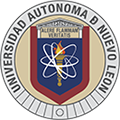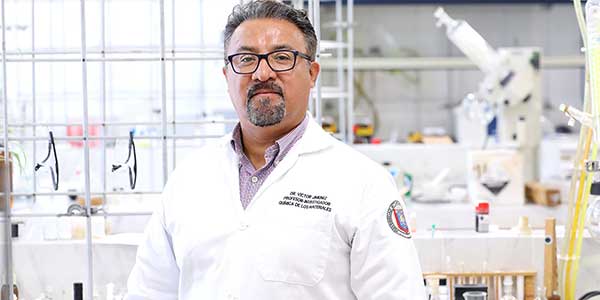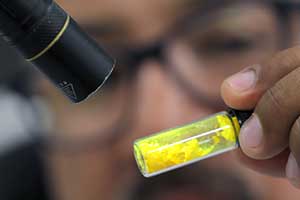Share:
The Staining Technique revolutionizes Cancer Cell Detection
Professors and graduate researchers from the UANL School of Chemical Sciences have developed a patented stain that aids in the selection and identification of abnormal cells within the organism.
In 2020, cancer was the leading cause of death worldwide, resulting in over 10 million fatalities. According to the WHO, early detection and treatment can significantly reduce cancer mortality.
To identify cancer cells more quickly and effectively, professors and graduate researchers from the School of Chemical Sciences at the Universidad Autónoma de Nuevo León have developed a patented stain that aids in selecting and identifying abnormal cells within the organism.
The research team, led by Professor Víctor Manuel Jiménez Pérez, has patented a staining method that uses fluorescent boron molecular rotors to select and identify these cells.
According to specialized literature, cancer cells have a high density, which allows the developed cellular staining to establish molecular rotation and fluorescent properties in abnormal cells. This makes it easier for surgeons to selectively extract cancerous cells without affecting healthy ones.
15 years of research
Jimenez Perez noted that the research team has been studying the non-toxic properties of boron for approximately 15 years. He added that the material’s non-toxicity ensures the preservation of both healthy and cancer cells, with cancer cells highlighted through luminescence.
Our initial paper on molecular rotors was published in 2017. However, our exploration of boron’s luminescent property began 15 years ago. We were particularly drawn to boron because of its non-toxic nature. This characteristic prompted us to leverage its biological and physical properties in cellular applications, ensuring that it doesn’t harm healthy cells due to its low toxicity”.
Víctor Manuel Jiménez Pérez
Research Professor, UANL School of Chemical Sciences
“We have molecular rotors that are tin-based toxicants used in in vitro assays, but these have no potential application in vivo. In contrast, boron compounds, due to their very low toxic activity, do not kill cells, thereby allowing us to advance this application,” he explained.
“We can scale this product to an industrial level, as it holds potential applications in biomedicine. Through this project, I believe we are contributing to solving this significant health issue,” he remarked.
Similarly, in the field of medicine, this type of molecular rotors could enhance the resolution of bioimaging. Moreover, in industrial applications, the project could serve as a molecular-level temperature sensor or viscosity sensor in oils.
“This patent is the result of a great team effort involving students and research professors. It’s a testament to the dedication of many individuals who have enabled us to make strides in the field of science,” he expressed.
The patent has received national recognition, securing a total of five industrial property registration titles from the Mexican Institute of Industrial Property.
Additionally, this year, the project was honored with the UANL Invention Award 2024, underscoring its significant contribution to innovation and scientific research in the state.
Posted by: Portal Web






